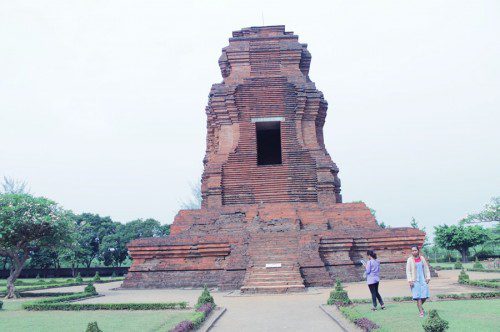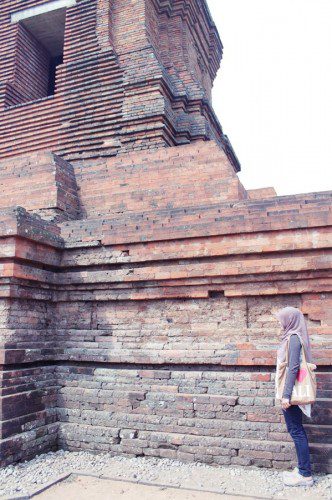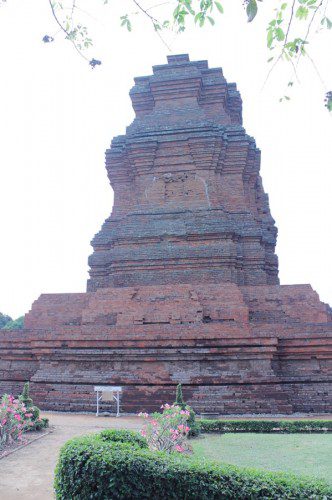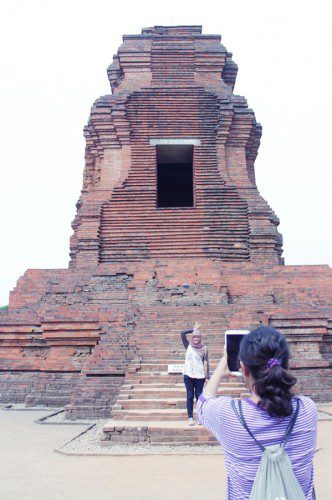インドネシア2代目支局長 フィルダBLOG

インドネシア通信vol.40 「ブラフお寺」
導入実績700サイト以上!!
「カスタメディア」の事例ダウンロードは
こちら
私が訪れたモジョケルトの第三のお寺は「ブラフ寺」と呼ばれています。「ブラフ寺」はテロウラン地区で最大のお寺です。「ブラフ」という単語はジャワ語で「ワナル」または「ワラフ」という単語で、これは神聖な建物の名前です。「ブラフ寺」は飾り気のない赤レンガや平野で作られており、ジャンムーメンタサブ村、村ベジジョン、モジョケルト摂政に位置しています。

このお寺は、22.5メートルの長さ、18メートルの幅、20メートルの高さの長方形の建物です。建物は、足、体、屋根の3つの部分で構成されています。その構造から、お寺は15世紀に建てられた仏教寺院になります。プセンドー表記には、このお寺は王ブラビジャヤ死の体を燃やすための場所で、火葬場として使われていたと書かれています。また、お寺の修復が1990年から1995年まで行われました。


「ブラフ寺」の形状は様々な大きさの正方形で、屋根は階層ではなく、フラット状です。これは仏教寺院の特徴で、「ブラフ寺」はマジャパヒト王国の前に建設されたと推測されています。
インドネシアのほとんどの寺院は、それぞれに違った形、機能を持っています。私は古代道具でお寺を建てた人に、大変驚いています。私は歴史的な場所を訪問し、歴史について知ることで、 歴史の重要性を感じました。

Bahasa Indonesia
Candi Brahu
Candi ketiga yang saya kunjungi di Mojokerto disebut ‘Candi Brahu’. Candi Brahu merupakan candi terbesar di kecamatan Trowulan. Kata ‘Brahu’ berasal dari ‘Wanaru’ atau ‘Warahu’ dalam bahasa Jawa, yang merupakan nama untuk bangunan suci. Candi Brahu terbuat dari batu bata merah dan polos tanpa hiasan.
Candi ini merupakan bangunan persegi panjang dengan panjang 22.5 meter, lebar 18 meter dan memiliki tinggi sekitar 20 meter. Bangunan ini terdiri dari tiga bagian, yaitu bagian kaki, tubuh dan atap candi. Dilihat dari gaya bangunannya, candi ini adalah candi Buddha yang dibangun pada abad ke 15. Berdasarkan prasasti Mpu Sendok, candi ini adalah tempat untuk membakar jasad Raja Brawijaya, jadi fungsi dari candi ini adalah sebagai tempat kremasi. Pemugaran candi Brahu dilakukan pada tahun 1990-1995.
Bentuk candi Brahu adalah persegi tegas dengan banyak sudut tumpul dan berlekuk. Atap candi bukanlah berbentuk prisma atau persegi panjang berjenjang, tapi berbentuk datar. Ini merupakan karakteristik candi Buddha. Ini memberikan asumsi bahwa candi Brahu dibangun sebelum Kerajaan Majapahit.
Hampir semua bangunan candi di Indonesia memiliki bentuk yang kokoh. Saya benar-benar kagum pada orang-orang yang membangun candi dengan alat sederhana di zaman kuno. Dnegan mengunjungi tempat-tempat bersejarah seperti Candi, saya menjadi lebih banyak tahu tentang sejarah dan pengaruhnya untuk masa sekarang. Hal itu membuat saya sangat menghargai pentingnya sejarah dalam kehidupan.
English
Brahu Temple
The third temple that I visited in Mojokerto is called ‘Brahu Temple’. Brahu temple is the biggest temple in Trowulan district. The word ‘Brahu’ is come from “Wanaru” or “Warahu” in Javanese language, which is name of holy building. Brahu temple is made of red bricks and plain without decoration. It is located in Jambu Menta sub-village, Bejijong village, Mojokerto regency.
This temple is a rectangular building with 22,5 meter length, 18 meter width, and 20 meter height. Its building consist three part, which is foot, body and roof. Seen from its style, this temple is a Buddha temple that built in 15th century. Based on Mpu Sendok inscription, this temple is place to burn King Brawijaya death body, so the function of this temple is crematorium. The restoration of this temple is done in 1990 * 1995.
The shape of Brahu temple is square indecisive with many obtuse angles and notched. The roof of the temple is not a prism-shaped or rectangular tiered, but a flat-shaped. It is the characteristic of Buddhist temples. It gave an assumption that Brahu temple was built before the Majapahit Kingdom.
Almost all the buildings of the temple in Indonesia has a solid form. I am truly amazed at the people who built the temples with a simple tool in ancient times. By visiting historical places like the temple, I know more about the history and repercussions for the present. It makes me really appreciate the importance of history in life.


